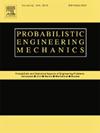Advances in dimension-reduction methods for simulating univariate and multivariate non-stationary stochastic processes via spectral representation
IF 3
3区 工程技术
Q2 ENGINEERING, MECHANICAL
引用次数: 0
Abstract
The novel dimension-reduction methods based on spectral representation for simulating both univariate and multivariate non-stationary stochastic processes are addressed. Initially, the original spectral (decomposition) representation of univariate (multivariate) non-stationary stochastic processes is derived. A unified expression for the original spectral decomposition integrating Cholesky decomposition and eigen decomposition is presented. Further, two typical random orthogonal functions associated with the standard orthogonal random variables in the original spectral (decomposition) representation are defined, resulting in the conventional Monte Carlo methods, namely the random amplitude method and the random phase method, are readily obtained. Meanwhile, two updated random orthogonal functions are introduced, enabling the dimension-reduction methods based on the random amplitude and the random phase respectively. The analysis above establishes that the original spectral (decomposition) representation forms the unified theoretical foundation for both the conventional Monte Carlo and the developed dimension-reduction methods. Essentially, both approaches are specific cases of the original spectral form. However, they share the same necessary conditions for simulation, though their sufficient conditions differ. Consequently, the dimension-reduction methods just require merely one to three elementary random variables for simulating univariate and multivariate non-stationary stochastic processes, significantly reducing the randomness of simulation from the level of thousands to an extremely low degree. Finally, numerical examples including the comparisons of simulation accuracy and efficiency between the conventional Monte Carlo methods and the dimension-reduction methods thoroughly substantiate the effectiveness and superiority of the latter.
求助全文
约1分钟内获得全文
求助全文
来源期刊

Probabilistic Engineering Mechanics
工程技术-工程:机械
CiteScore
3.80
自引率
15.40%
发文量
98
审稿时长
13.5 months
期刊介绍:
This journal provides a forum for scholarly work dealing primarily with probabilistic and statistical approaches to contemporary solid/structural and fluid mechanics problems encountered in diverse technical disciplines such as aerospace, civil, marine, mechanical, and nuclear engineering. The journal aims to maintain a healthy balance between general solution techniques and problem-specific results, encouraging a fruitful exchange of ideas among disparate engineering specialities.
 求助内容:
求助内容: 应助结果提醒方式:
应助结果提醒方式:


